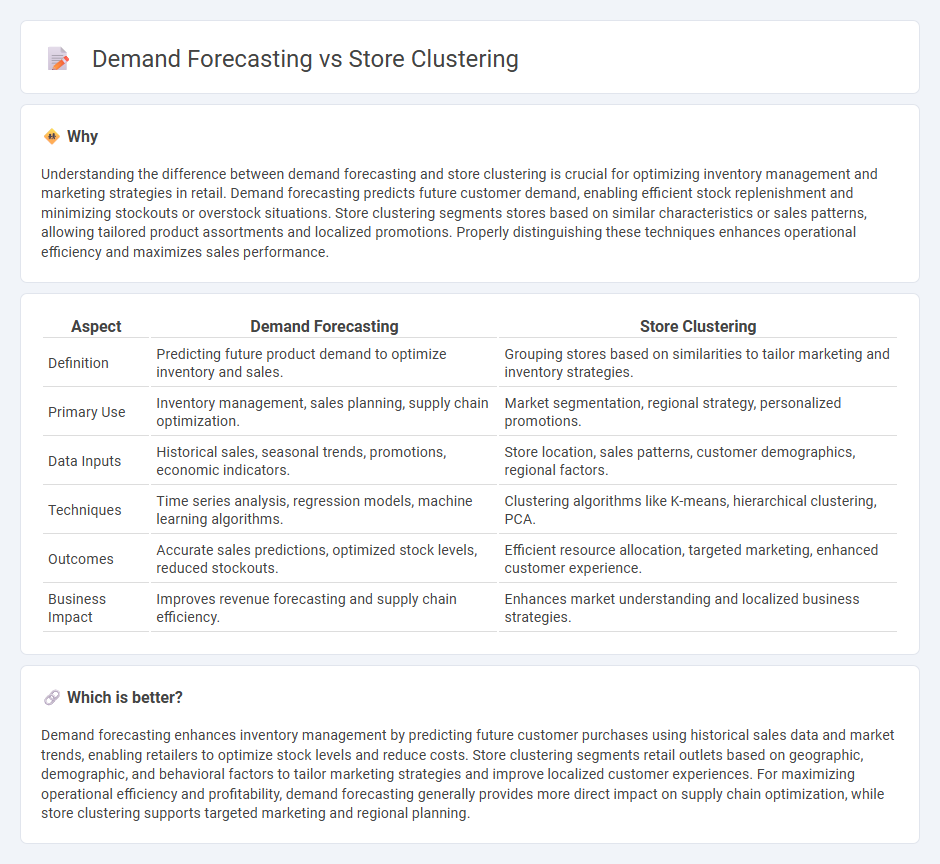
Demand forecasting uses historical sales data and predictive analytics to estimate future product needs, enabling retailers to optimize inventory and reduce stockouts. Store clustering segments stores based on characteristics like location, customer demographics, and sales patterns to tailor marketing strategies and inventory management. Discover how combining demand forecasting with store clustering enhances retail efficiency and profitability.
Why it is important
Understanding the difference between demand forecasting and store clustering is crucial for optimizing inventory management and marketing strategies in retail. Demand forecasting predicts future customer demand, enabling efficient stock replenishment and minimizing stockouts or overstock situations. Store clustering segments stores based on similar characteristics or sales patterns, allowing tailored product assortments and localized promotions. Properly distinguishing these techniques enhances operational efficiency and maximizes sales performance.
Comparison Table
| Aspect | Demand Forecasting | Store Clustering |
|---|---|---|
| Definition | Predicting future product demand to optimize inventory and sales. | Grouping stores based on similarities to tailor marketing and inventory strategies. |
| Primary Use | Inventory management, sales planning, supply chain optimization. | Market segmentation, regional strategy, personalized promotions. |
| Data Inputs | Historical sales, seasonal trends, promotions, economic indicators. | Store location, sales patterns, customer demographics, regional factors. |
| Techniques | Time series analysis, regression models, machine learning algorithms. | Clustering algorithms like K-means, hierarchical clustering, PCA. |
| Outcomes | Accurate sales predictions, optimized stock levels, reduced stockouts. | Efficient resource allocation, targeted marketing, enhanced customer experience. |
| Business Impact | Improves revenue forecasting and supply chain efficiency. | Enhances market understanding and localized business strategies. |
Which is better?
Demand forecasting enhances inventory management by predicting future customer purchases using historical sales data and market trends, enabling retailers to optimize stock levels and reduce costs. Store clustering segments retail outlets based on geographic, demographic, and behavioral factors to tailor marketing strategies and improve localized customer experiences. For maximizing operational efficiency and profitability, demand forecasting generally provides more direct impact on supply chain optimization, while store clustering supports targeted marketing and regional planning.
Connection
Demand forecasting uses historical sales data and market trends to predict future product needs, enhancing inventory management. Store clustering groups retail locations based on similarities in customer demographics, sales patterns, or geographic factors, enabling tailored marketing and stocking strategies. Integrating demand forecasting with store clustering allows retailers to optimize inventory distribution and improve sales performance by aligning stock levels with specific cluster demands.
Key Terms
Customer Segmentation
Store clustering groups retail locations based on sales patterns, demographics, and geographic proximity to optimize inventory and marketing strategies. Demand forecasting predicts future product demand using historical sales, seasonal trends, and external factors to ensure stock availability and reduce costs. Explore how integrating store clustering with demand forecasting enhances customer segmentation insights for targeted retail strategies.
Sales Prediction
Store clustering groups retail locations based on factors such as customer demographics, purchasing behavior, and location characteristics to enhance targeted marketing and inventory management. Demand forecasting uses historical sales data, market trends, and seasonality patterns to predict future product demand and optimize supply chain efficiency. Explore effective strategies for integrating store clustering and demand forecasting to significantly boost sales prediction accuracy.
Inventory Optimization
Store clustering groups retail locations based on similar sales patterns, customer demographics, and regional behaviors, enabling tailored inventory decisions that reduce overstock and stockouts. Demand forecasting predicts future product needs using historical sales data, seasonality, and market trends, driving accurate stock replenishment and avoiding excess inventory costs. Explore how integrating store clustering with demand forecasting enhances inventory optimization for improved supply chain efficiency.
Source and External Links
Store Clustering for Improved and Efficient Inventory Planning - Toolio - Store clustering groups stores with similar characteristics like sales, store size, or product categories to tailor inventory planning and improve operational efficiency, preferably using algorithms such as K-means for precision.
Store Clustering - KI Value - Store clustering segments stores based on factors such as location, customer demographics, and sales patterns to optimize inventory, marketing, and operations by developing cluster-specific strategies that minimize stockouts and excess inventory.
Store Clustering - Lark - Store clustering groups retail stores by location, customer demographics, and purchasing patterns, enabling personalized marketing, inventory management, and operational improvements through advanced analytics and AI for data-driven decisions.
 dowidth.com
dowidth.com